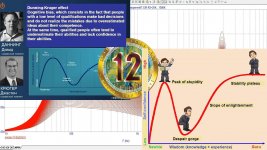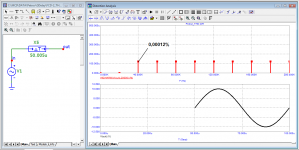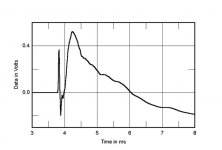Isn't it basically that it "ignores" the discontinuity.
You mean the simulator? How can it do that? How does it know what is a discontinuity or a wanted signal?
A simulator is just a dumb piece of math routines, it does not understand 'signal' or 'circuit', it just runs math subprograms on a circuit list to calculate the voltage at each node and the current through each branch.
Jan
There is a lack of scientifically based evidence base and an attempt to axiomatize speculation. Where did you get this multiplicity? Why not 7 or 13? You try to use the old tricks of sophistry with a straight face.It is known that for undistorted signal transmission, the group delay time should be with a tenfold margin, that is, it should be constant in magnitude up to a frequency of 200 kHz.
You also do not understand how the Microcap works and how to correctly evaluate the results obtained. When you send a burst of a sinusoidal signal, you send a mixed signal from the step effect and directly from the sinusoidal signal. When analyzing the first period, the conversion window does not get a pure sine, but together with the response of the amplifier to a step effect, that is, a transition process with a broadband tail. And this is all you are trying to analyze and relate to the sound quality of the amplifier. You don't understand that this doesn't happen during normal operation of the amplifier due to the limited input signal spectrum. I have pointed this out to you many times before, and even in this topic, knowledgeable colleagues have repeatedly reminded you, but you ignored their words, as well as my questions.When my colleagues start telling me about the distortions of the first period in the simulator, I immediately understand that this colleague has no idea how the simulator works, in particular Microcap. For information: the program counts according to the last period from the burst that we set for analysis. If we set a burst of five periods, then the program will make a test for the 5th period by substituting it multiple times in front and behind so that the signal turns into a periodic one. The program does not pay attention to the phase of the signal, it is important that the period is whole. That's all you need to understand. The program works in the same way for the first period.
Later versions of the Microcap even specifically introduced The "Periodic Steady State" marker in the "Limits" window. Read the help in your free time and learn how to use this feature.
The site owner / editor runs an audio electronics retail business. Enough said.Great marketing piece! Lots of impressive words and sentences, no content.
You also do not understand how the Microcap works and how to correctly evaluate the results obtained. When you send a burst of a sinusoidal signal, you send a mixed signal from the step effect and directly from the sinusoidal signal. When analyzing the first period, the conversion window does not get a pure sine, but together with the response of the amplifier to a step effect, that is, a transition process with a broadband tail. And this is all you are trying to analyze and relate to the sound quality of the amplifier. You don't understand that this doesn't happen during normal operation of the amplifier due to the limited input signal spectrum.
Very well said.
This is absolutely correct.
Stein
Jan, if I understood correctly this is a video signal amplifier with an output impedance of 50 ohms. And although there is an output with an impedance of 1 Ohm to a 4 Ohm load, it is unlikely to be able to work, since the load impedance can drop several times. I am interested in an amplifier for sound applications in your performance (if there is a non-commercial development).
Perhaps something more apt to audio: http://www.sintefex.com/docs/appnotes/dynaconv.PDF
Wrong thread 😉
first decide on your place on this chart, and then start teaching othersI have pointed this out to you many times before, and even in this topic
Attachments
Let's check the statement of Kiryll Hammer about the signal transmission delay of several ns. As you can see, with a signal delay of 5 ns, the distortions of even the first period are already negligible. Graham wrote about this repeatedly and confirmed by some colleagues who noted that faster amplifiers were in a winning position in terms of sound quality.
Attachments
Let's check the statement of Kiryll Hammer about the signal transmission delay of several ns. As you can see, with a signal delay of 5 ns, the distortions of even the first period are already negligible.
Again, these are not distortions. These are spectral components that are part of the signal you created. You created a 20kHz signal with a lot of harmonics. Of course you see the harmonics - you yourself put them there by defining an infinitely fast starting sine!
I can't believe that you don't ask yourself: if this is distortion, what is doing the distorting??
Jan
Let's check the statement of Kiryll Hammer about the signal transmission delay of several ns. As you can see, with a signal delay of 5 ns, the distortions of even the first period are already negligible. Graham wrote about this repeatedly and confirmed by some colleagues who noted that faster amplifiers were in a winning position in terms of sound quality.
A delay causes distortion? How. Your pics show nothing. This has gotten so ridicoulus its not even funny anymore.
He probably doesn't get that, it's surprising, but some otherwise quite knowledgeable people here seem to have a mental block about it.you yourself put them there by defining an infinitely fast starting sine!
My thoutghs:
If there is a topic with such a clear theme and target, it's very strange
(and sad) to me that there are a lot who only attacks the exploration with
the concept that a new thing is surely unneccasary and wrong in every way.
I admit that the new method is not yet fully developed (on the contrary), but
the common process (the team work) could be much more "open minded" and efficient:
for example trying to take it as a question, or as a possible new way of testing
and understand the original aim/approach assuming that there can be still some
new aspects during our common brain-storming exploration.
And I guess there is also some miscommunication around this FFT vs FCD issue:
FFT is a great way to analyze the output of an amplifier from a specific aspect
but it's definitely not ultimate regarding ultimate audio quality vs human hearing.
After a certain level it's only "just" 0.000x numbers which we all know doesn't
correlate with the human ear related audio quality and so maybe we should look
for new testing approaches and maybe we should look for new "domains", axes.
An intentionally silly example:
We could test our amplifiers based on their weight, right?
We could check how this result correlates with the subjective audio quality.
We could get the result that sometimes it does.
So we could go on and develop even more precise scales until the microgramms.
Please note that the measuring system and framework is complete and perfect,
and it contains everthing (at least from that very specific aspect it measures.)
But after a certain level it will be useless and we have to look for another
method which will correlate better with our human ear based perceptions.
Of course I dont have any hi-tech lab and proofs for this, but even so I am pretty sure
that our ears are (not perfect) but very good sensors (including our brains of course).
But I am also sure that it has a very special "priority list" with some special preferences.
Maybe there are some phenomanas that are subtle to a THD domain but extreme relevant to our hearing.
For example it can be that an amplifier with a same or worse THD can sound much better to our ears.
And exactly that's why we should keep going and try to find something new which represents our ear
sensitivites much better based on the same "electrical" environment but using completely different funds.
Maybe the THD domain is "fulfilled" years ago but we lost the contact with our final and uttermost goal.
And once againg: why do you reject to use a "non-normal" and/or fast test signal as a probe?
We are now in "development mode" and not in the final "music listening mode".
These kind of test targets to magnify something that's there but "hides" with the normal test.
Like using UV light to show the germs which are always there yet are invisible even if you
use a perfect but "conventional" lightsource. The problem (distortion) can be similar: indirect.
The germs are invisble so we have to use special methods to get them visible directly.
You also could say: why to use UV lamps if we dont use them in our normal life..?
Beacuse we are blind and if we dont care still we can get sick.
And that's how a special transient test signal can help to bring
up somethings thats still hiding...
If there is a topic with such a clear theme and target, it's very strange
(and sad) to me that there are a lot who only attacks the exploration with
the concept that a new thing is surely unneccasary and wrong in every way.
I admit that the new method is not yet fully developed (on the contrary), but
the common process (the team work) could be much more "open minded" and efficient:
for example trying to take it as a question, or as a possible new way of testing
and understand the original aim/approach assuming that there can be still some
new aspects during our common brain-storming exploration.
And I guess there is also some miscommunication around this FFT vs FCD issue:
FFT is a great way to analyze the output of an amplifier from a specific aspect
but it's definitely not ultimate regarding ultimate audio quality vs human hearing.
After a certain level it's only "just" 0.000x numbers which we all know doesn't
correlate with the human ear related audio quality and so maybe we should look
for new testing approaches and maybe we should look for new "domains", axes.
An intentionally silly example:
We could test our amplifiers based on their weight, right?
We could check how this result correlates with the subjective audio quality.
We could get the result that sometimes it does.
So we could go on and develop even more precise scales until the microgramms.
Please note that the measuring system and framework is complete and perfect,
and it contains everthing (at least from that very specific aspect it measures.)
But after a certain level it will be useless and we have to look for another
method which will correlate better with our human ear based perceptions.
Of course I dont have any hi-tech lab and proofs for this, but even so I am pretty sure
that our ears are (not perfect) but very good sensors (including our brains of course).
But I am also sure that it has a very special "priority list" with some special preferences.
Maybe there are some phenomanas that are subtle to a THD domain but extreme relevant to our hearing.
For example it can be that an amplifier with a same or worse THD can sound much better to our ears.
And exactly that's why we should keep going and try to find something new which represents our ear
sensitivites much better based on the same "electrical" environment but using completely different funds.
Maybe the THD domain is "fulfilled" years ago but we lost the contact with our final and uttermost goal.
And once againg: why do you reject to use a "non-normal" and/or fast test signal as a probe?
We are now in "development mode" and not in the final "music listening mode".
These kind of test targets to magnify something that's there but "hides" with the normal test.
Like using UV light to show the germs which are always there yet are invisible even if you
use a perfect but "conventional" lightsource. The problem (distortion) can be similar: indirect.
The germs are invisble so we have to use special methods to get them visible directly.
You also could say: why to use UV lamps if we dont use them in our normal life..?
Beacuse we are blind and if we dont care still we can get sick.
And that's how a special transient test signal can help to bring
up somethings thats still hiding...
If minimizing “delay distortion” is the holy grail of audio, why don’t we see more reports of subjective superiority of high BW amplifiers? Through the years several high BW audio amps (~1MHz) appeared and quietly disappeared from the scene. Forgotten.
Actually tube amps, preferred by many, are typically quite limited in BW.
And what about transducers? What is the chance for amplifier rise time to make any difference in the speaker impulse response (chart copied from Bowers & Wilkins 705 Signature loudspeaker Measurements | Stereophile.com)?
Actually tube amps, preferred by many, are typically quite limited in BW.
And what about transducers? What is the chance for amplifier rise time to make any difference in the speaker impulse response (chart copied from Bowers & Wilkins 705 Signature loudspeaker Measurements | Stereophile.com)?
Attachments
And once againg: why do you reject to use a "non-normal" and/or fast test signal as a probe?
We are now in "development mode" and not in the final "music listening mode".
These kind of test targets to magnify something that's there but "hides" with the normal test.
Like using UV light to show the germs which are always there yet are invisible even if you
use a perfect but "conventional" lightsource. The problem (distortion) can be similar: indirect.
The germs are invisble so we have to use special methods to get them visible directly.
You also could say: why to use UV lamps if we dont use them in our normal life..?
Beacuse we are blind and if we dont care still we can get sick.
And that's how a special transient test signal can help to bring
up somethings thats still hiding...
If a device is designed for a specific application why would you test it out of range of the application. Its like testing a tractor in a wind tunnel to try to increase horsepower, theres no point. Its a waste of time, money and pretty ridiculous. The same goes for testing audio BW gear with Mhz signals. Thats what these are. Like the tractor, ridiculous.
Because there can be some effects that are subtle/hiding but they affect the final result significantly.why would you test it out of range of the application
In such cases we have to magnify them somehow. And then, when they are big and visible, then we can catch them easier.
Note that why we have to use a microscope after a level to analyze things?
Or how useful a slow motion can be if we want to understand a transient process and how it's really working:
How Weed Eaters Work (at 62,000 FRAMES PER SECOND) - Smarter Every Day 236 - YouTube
(Listen to the content around 9:00!)
And in some cases we have to speed things up to achieve the same magnifying result.
Last edited:
- Home
- Amplifiers
- Solid State
- First cycle distortion - Graham, what is that?


